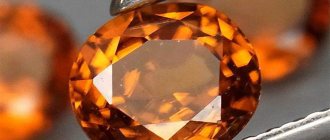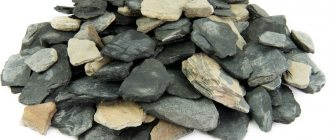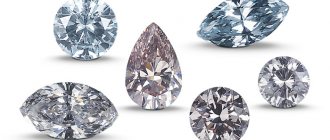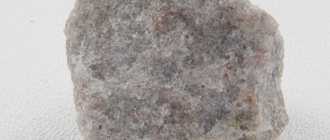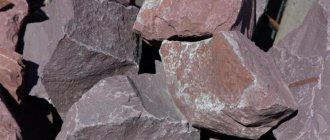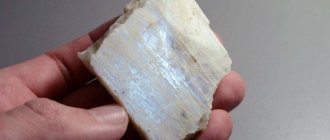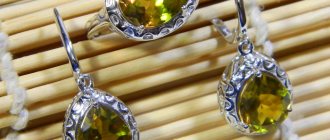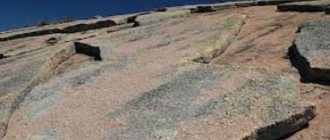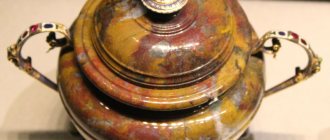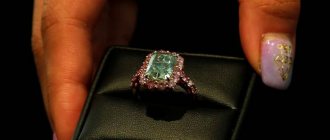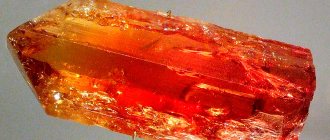Due to difficulties in processing the material, for a long time only uncut diamonds were used for technical and jewelry purposes. This natural solid mineral is not distinguished by its bright natural shine and beauty. On the other hand, through the process of careful polishing, the stone turns into an expensive diamond. Rough diamonds are characterized by useful properties, so the materials are used to solve production problems and even for jewelry.
What is diamond as a mineral?
Diamond is a representative mineral that has been used by people since ancient Egypt. Since ancient times, the stone has been called “indestructible” because of its hardness. The color of natural gems is characterized by unevenness, and a rough diamond shines in X-rays.
Due to their ability to refract light, uncut stones are professionally processed into sparkling works of art. Unpolished stone is characterized by a variety of shapes, but most often it is a cube, octahedron, or dodecahedron. Not everyone can recognize a natural untreated diamond that looks inconspicuous. Only professional jewelers are able to assess the hidden value and potential of a gemstone and fill an unprepossessing mineral with a bright light of life.
Rough diamonds differ in the following parameters:
- purpose;
- physical and chemical properties;
- color;
- sizes;
- inclusions.
This stone is characterized by a variety of colors. There are colorless with yellowish, red minerals. Brown, greyish, blue, black and even green diamonds are also not uncommon. By purpose, natural minerals are called technical or jewelry. According to size, stones are classified into small, medium and large. The originality and uniqueness of each specimen is determined by inclusions in the form of cracks, the presence of internal voids, and inclusions of foreign substances.
Properties and applications of diamonds
Stone is classified as a native element, that is, formed in nature without human intervention. According to the mineral classification, diamond is a polymorph of carbon. Despite its high cost, the mineral is used in many industries:
- medicine - they make scalpels and microsurgical instruments;
- electronics - prevents sensitive devices from overheating;
- telecommunications - radio signal sensors;
- mining industry - giving strength to drills;
- They make jewelry and cosmetics from diamonds.
The widespread use of the mineral is possible due to the peculiarities of its structure and physical and mechanical properties. About 15% of the mined crystals are used to make jewelry. 45% is left for storage for subsequent cutting. 40% of crystals are used for technical purposes.
Watch a video about the use of diamonds. The author claims that this is the stone of the future and it will find application in any field:
Physical properties
The chemical formula of diamond contains only one element - C, carbon. Sometimes it contains impurities - atoms of boron, iron, nitrogen. Its molecular weight is 12 units. The molecular structure of the mineral is a crystal lattice of regular shape.
The hardness of diamond on the Mohs scale is 10 units. It is the hardest mineral existing on Earth. Greater hardness is explained by strong bonds between carbon atoms. In industry, hardness is determined by Rockwell; in diamonds, it is designated by the letter A.
Diamond density is 3.5 grams per cubic centimeter. This figure corresponds to the specific gravity of the mineral. Given the same volume, diamond weighs 3.5 times more than water.
Despite its hardness, diamond is a fragile stone. Therefore, you can break a diamond if you hit it hard with a hammer. The stone is not affected by acids, but is sensitive to alkalis.
Syngony is a characteristic of the crystal lattice of a mineral. In diamond it is cubic, that is, all the atoms in it are arranged in the form of cubes. The crystal structure determines the exceptional hardness of the mineral.
In terms of optical properties, diamond is isotropic - its structure is homogeneous and completely transparent. The refractive index of light is 2.4, there is no double refraction of light rays.
Knowing this figure, you can calculate the speed of light in a diamond - you need to divide the speed by the refractive index. That works out to 124 million meters per second.
There are several melting temperatures of the mineral depending on air access and pressure:
- in air it burns at a temperature of 800 degrees, turning into carbon dioxide;
- in a vacuum, the stone does not burn, but transforms into graphite at a temperature of 2000 degrees;
- at a pressure of 11 GPa the melting point reaches 4000 degrees.
An interesting property of the gemstone is luminescence. Under sunlight, and even more strongly under ultraviolet and x-ray radiation, the stone glows in different colors.
For a story about physical characteristics, watch the video:
Medicinal properties
Thanks to its powerful energy, diamonds are used for medicinal purposes. It is able to influence the condition of internal organs:
- alleviates inflammatory processes;
- reduces the manifestations of skin diseases;
- improves mood;
- strengthens the reproductive system of women.
For treatment, the mineral is applied to the surface of the skin. You can also put it in water for a day, and then drink the energy-charged liquid.
Magic properties
People began to attribute magical properties to the precious stone as soon as they became acquainted with it. This was facilitated by the energy emanating from the mineral. It is so strong that it can influence the aura of the owner. The features of the magical properties of diamond include:
- a positive impact on a person’s life is detected only if the jewelry was presented as a gift;
- the stone protects the owner from dangers; it is believed that it can neutralize poisons;
- a person who owns the mineral becomes more self-confident, stronger and more resilient.
Diamond talismans help a person find his love. For this property to manifest itself, you need to wear the stone on your left hand. Amulets made from the yellow mineral are used by sorcerers and esotericists to perform magical rituals.
Diamond is the main zodiac stone. It can be worn by people with any zodiac sign, but most of all it suits Leo and Aries.
Listen to an interesting recording about the magic of diamond:
Purpose of diamond minerals
An uncut diamond does not have a strong aesthetic appeal. Because of the way this stone looks, it can easily be confused with other minerals. To obtain a diamond that sparkles even in the dark during the cutting process, you need to use the right source material.
The main diamond production (approximately 85%) comes from technical varieties, which are used for processing super-hard materials. High-strength metal cutters, drilling equipment, and abrasive tool products are made from these stones. You can learn more about this from the article “Areas of application of industrial diamonds.”
There are not enough of these minerals in nature, so to satisfy production and aesthetic needs, people have learned to grow diamonds in laboratory conditions. Black carbonado, gray ballas, milky white bead are representatives of artificial stones.
The most valuable diamonds for the production of high-quality jewelry are rough jewelry diamonds, which are distinguished by their high-quality color and clarity. During processing, they lose about 50% of their mass, acquiring the extraordinary aesthetic appeal of a true diamond. Such specimens are considered very rare, and after cutting they fetch a high price. High-quality uncut crystals attract many collectors who are willing to pay large sums for unique pieces.
The rough material is graded in accordance with the standards of the International Diamond Council and the Gemological Institute of the United States. Such requirements imply the use of special technology to determine the value of natural material. More information about the evaluation of diamonds after processing can be found in the article “Evaluating Diamonds by Clarity and Other Parameters.”
Quality and shape
According to statistics, only 20-25% of the raw materials mined in the world are used by jewelers. Only high-quality rough diamonds with impeccable color and clarity become part of precious jewelry.
Crystals with obvious defects, inclusions or foreign impurities are considered “technical”. Pebbles of poor quality and ugly color are needed in industry. In the same category there are gems of irregular shapes and too small sizes. They are used to make diamond dust, that is, they are crushed.
It is known that a diamond is a processed diamond. Its final form depends on the natural one acquired in nature. Uncut diamonds look dull and unattractive. The cutting process makes it sparkling, smooth, and expensive. Read more about the difference between a diamond and a diamond →
Without processing, the mineral is not particularly valuable, and they ask for no more than a hundred dollars. But a diamond made from diamond costs 4-10 times more.
The cost is also affected by the type of cut, which can be:
- round;
- fantasy.
Before processing, an oblong diamond takes on shapes called:
- marquis;
- drop/pear;
- oval;
- heart.
Stones, whose natural appearance had almost ideal outlines, receive one of the following forms:
- emerald;
- usher;
- radiant;
- princess.
Processing diamonds into round brilliants is a labor-intensive process that requires strict adherence to proportions. This causes the high cost of the round product. Learn more about how many facets a diamond has →
Mining natural diamonds
Natural diamond minerals are mined all over the world. The largest deposits of these stones are located in the Congo, Namibia, South Africa, and Russia. Diamonds are also mined in Australia, Canada, and Angola. Due to the high cost and difficulty of extracting this stone, its source was most often secondary deposits that arose as a result of the destruction of rocks. Old technologies were reminiscent of gold mining through sifting river sand, from which mineral crystals were carefully washed out.
Today, with the help of modern technologies, people have learned to extract precious raw materials from primary rock, which is called a “kimberlite pipe.” Preparatory work for mining consists of creating depressions by blasting and laying shafts. Huge volumes of ore are delivered to factories where screening, grinding, washing, acid treatment of the material, and X-ray screening take place.
The production process can be called quite labor-intensive. Before it falls into the hands of a master who will do the actual cutting, hundreds of tons of rock are processed. More details about these processes can be found in the article “On diamond mining in the world.”
Diamond color and size
Colorless or slightly colored crystals are more common: yellow, brown, gray crystals. Stones of greenish, bluish and pink shades are less commonly found. And diamonds of bright pure tones of blue, green and red are very rare.
A colorless diamond is considered the most valuable, with the exception of rare and very expensive stones of bright, pure tones of blue, green, and red.
The most valuable diamonds are considered to be pure, transparent, colorless stones that acquire a bluish tint when cut - the so-called “blue water” diamonds.
Diamonds with overcolor: yellowish, greenish and others are less expensive.
Stones with a large number of defects - cracks, dots, random inclusions, etc., as well as cloudy stones of gray, brown and dirty tones (edge) are not cut and used for technical purposes.
Particularly highly prized are completely transparent, brightly colored stones: green, yellow, red and extremely rare blue and black diamonds.
One of the most valuable diamonds in the world is the deep blue Goppe stone from India, weighing 44.5 carats.
Paul I paid 100 thousand gold rubles for a red diamond weighing 10 carats.
The largest diamonds are very expensive. They are given their own names, each of them has its own history, in most cases full of dark and tragic events.
The largest companies in the global diamond mining industry are the Russian Alrosa, the transcontinental De Beers, the Australian BHP Billiton and Rio Tinto, the South African Ponahalo, and the Canadian Vaaldiam Resources Ltd. and Tahera Diamond Corporation, the Brazilian Brazilian Diamonds Ltd. etc.
There are three ways to organize the extraction of diamond-bearing ore:
in diamond quarries (in deposits where the rock lies close to the surface and can be extracted using an open method, essentially a large hole).
in underground mines (in deposits where diamond ore lies deep from the surface, you have to drill vertical diamond mines and go down inside).
in diamond mines (combined method).
Processing of diamond gems
The author's efforts to process stones by hand focus on specific operations that are carried out in a specific order. In the first stages, after inspection, neat cuts are made along the intended lines, after which the stone is split with a directed blow. To cut natural diamonds, limestone or gypsum is used, with which the mineral is attached to the copper head. It is clamped in a cutting tool and sawed using a thin disk with diamond inclusions, which is lubricated with oil. This work is carried out carefully at a speed of 1 mm/hour.
Further, as a result of friction against each other, the minerals become round. Cutting is carried out using a special grinding machine (quadrant), which ensures the exact angle of the workpiece to the working disk.
Thanks to laser machines, the diamond processing process has become easier. After assessing the source material by specialists who determine the processing method, laser drawing of cutting lines, cutting and cutting occurs. This processing makes it easy to shape diamonds into desired shapes, but a lot of the original material is lost. Only a true master can create a real diamond that will decorate any jewelry collection. Usually one stone is processed by several people. You can learn more about processing technology from the article “How cutters process diamonds.”
Fashion for raw stones
Contemporary jewelry art is characterized by a desire for individuality and uniqueness. Style, design, materials must correspond to the internal content of the individual. For this, it seems, it is not enough to simply enhance the product with an expensive diamond or use precious metals. It is important to find the most favorable combination of materials and shapes. Today's technologies make it possible to bring any design ideas to life, so rough diamonds are becoming more and more common in finished jewelry masterpieces.
The increased interest in raw gemstones is also due to the fact that they are more accessible to jewelers and individual artisans who sell their products online. The ideal of such beautiful products is natural beauty, which breaks through unpredictable colors and rough natural forms. The geometric perfection of shiny edges, playing with a richness of bright colors, fades into the background. The main thing is the originality of the original stones, filled with precious contents. Such materials personify the naturalness of female beauty. It is the nuggets of femininity that are valued most highly in any society.
Designer jewelry with rough diamonds
Jewelry that is made using natural diamonds is distinguished by a certain mystical aura. Such jewelry is characterized by the special beauty of natural irregular shapes, a mysterious shine that strives to break through the matte surface of a noble stone that has a centuries-old history.
About ten years ago, the best jewelry makers decided on a bold experiment, combining the ideal facets and brilliance of a precious diamond with the hidden energy of rough diamonds. Among jewelry, medallions that carry the mystery of ancient rituals have become especially popular. Rough wild diamonds are characterized by unpredictable colors, the natural beauty of a rough angular shape, accumulated over centuries of energy from the depths of the earth. High-quality jewelers take into account the traditions of different cultures and peoples in their work. For example, unique designer products are offered in the style of the ancient Scythians.
Men's jewelry became especially widespread. Laconic medallions, bracelets, rings, the design of which was developed specifically for men, adorned the collections of famous manufacturers. For example, the main piece of the Talisman collection is rightfully considered the Wonderous Sphere disk, decorated with diamonds and rotating in three-dimensional space. In its design, it replicates ancient astronomical instruments. Its cost is estimated at a million dollars.
Have you encountered uncut diamonds? If the article is of interest and has lifted the veil of the secrets of precious stones, then please “like” it. Leave your comments. Share interesting information on social networks.
(
4 ratings, average: 5.00 out of 5)

